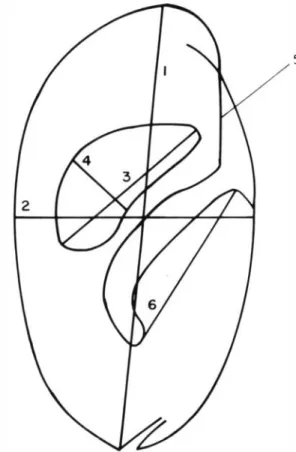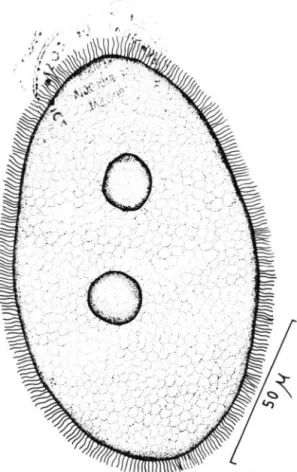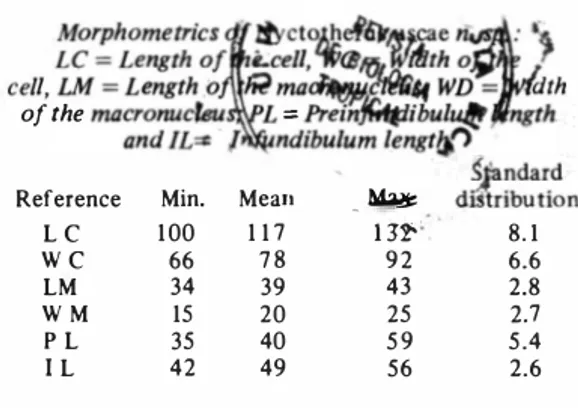Zelleriella bayonai n sp and Nyctotherus uscae n sp (Protozoa) from Leptodeira maculata (Colubirdae) of Guatemala, C A
Texto completo
(2) 238. REVISTA DE BIOLOGIA TROPICAL. found N. scinci in the saurian Scincus scincus. J anakidevi ( 1 96 1 ) described N. hardwickii found in the intestine of 1 5 saurians Uromastyx hardwickii from Bombay, India. A collection of the ciliate endocommensals heterotrichids species was recently completed by Albaret ( I 975). MATERIAL AND METHODS The protozoans were obtained from the posterior portion of the intestine of two "cantil" (Leptodeira maculata), caught in Mon terrico, Taxisco, Santa Rosa, Guatemala, on Ju Iy 1 978. The samples were fIXed in alcohol formalin-acetic acid. After through shaking the samples were sieved twice and passed to a test tube ( 1 3 x l OO) in which they were rinsed with distilled water and stained with Van Cleave and/or DelaField hematoxylin. Solutions were carried out centrifugated at 1 500-2000 r.p .m. to recover the sample, which was dehydrated in alcohol series, transparentated in xilol and mounted in neutral synthetical resino I S O Zelleriella and 25 Nyctotherus samples were measured microscopically. The drawings were based on microphotographs and micropro yections. Values are given in micrometers (J.lm) according to the plane indicated in figure 1 for í'.elleriella and figure 2 for Nyctotherus. RESULTS Zelleriella bayonai n. sp. (Figs. 3 , 4 , 5 ; Tables 1 ,2) Deseription : Cell openly ellipsoidal, without notable difference in the anterior ending, stria eovered with cilla in oblique direetion with regard to the transversal plane of the cell. There is not difference between endoplasm and cctoplasm. Vesicular nucIei aproximately equal in size, the previous one located at the longitu dinal half line and over the ecuatorial level of the body, and the posterior one located below this leve l, generally slanted toward one of the sides of the longitudinal half line. Host : Leptodeira maculata (Colubridae). Localization: Last portion of the intestine. Geografie Distribution : El Rinconcito, Monterrico, Taxisco, Santa Rosa, Guatemala. Discussion: These opalinids with flattened bodies and two nucIei belong to the genus. Zelleriella Metcalf, 1 920 , which is composed of species described almost excIusively from amphibia, with a few reported in fishes and reptiles (Cunha and Penido , 1 926 ; Metcalf, 1 949 ; Sandon, 1 980). Three speeies of this genus have been reported in reptiles : Z. lepto deirae Beltrán, 1 95 1 (Fig. 5a) ; Z. jaegeri Carini, 1 93 3 (F ig. 5b) and Z. biopevae Carini 1933 (Fig. Se). Zelleriella bayonai differs from other species in the shape of the body which is openly ellipsoidal, and in the position of the nucIei. The species cIoser to Z. bayonai is Z. biopevae, aceording to the morphometries data (Table 2). However, the position and diameter of the nucIei indicate that it is a new species, since the standard deviation of Z. bayonai shows a high degree of homogeneity, mainly about the greater diameter of their nucIei. The species is dedicated to the mexican microbiologist Armando Bayona-González (taking the singular masculine of his frrst name). Nyctotherus uscae n. sp. (Figs. 6, 7 , 8 ; Table 3) Description : Oval cell flattened late rally , covered by parallel stria of cilia of uniform length. They are larger and thicker at the peristome level (cirrus). There is no kariophore. Macronucleus almost triangular in shape with the posterior side flattened and parallel to the infundibulum , positioned aproximately at 400 from the transversal half line, anterior convex part with its lateral ex treme narrower, directed toward the peristome and the opposite ex treme oblique to longitudinal plane ending in the equatorial level of the cell. Posterior end of the cell rounded in more than one third of its last portion, under the transversal half lineo The peristome occupies one third of the ventral part and continues toward the apical extreme. The cytopyge forms a right tube that is opened in the antapex and continues in oblique direction toward the ventral side of the cell. The measu rements are given in Table 3 . IIost : Leptodeira maculata (Colubridae). Localization : Last portion of the intestine. Geographie Distribution : El Rinconcito , Monterrico, Tax isco, Santa Rosa, Guatemala. Discussion : The species Nyctotherus Leidy, 1 849 obtained in reptiles does not have kariophore (Fig. 8). Our species differs from.
(3) GALAVIZ & J 1MENEZ: Two protozoans from Leptodeiva. 239. 5. :3 2. Fig. 1. Planes uscd for measuring Zelleriella bayonai n. sp. : ( 1 ) Maximum length of the cell ; (2) Maximum. width ; (3) Distancc between nuc\ci ; (4) Major distancc between the nuclcus and cellular mcmbranc : ( 5 ) Dia· meter of the major nuclcus. TA B L E. 1. TA B L E. Morphometrics of Zcllcriella bayona i : LC Length of the cell, WC Width of the cell, NCM Major distan ce between the nuc1eus and cell membrane, NN Distance between the nuc1eus and DM Dio· meter of the greatest nuc1eus. =. =. =. =. References Le. WC NCM NN DN. N.. Hg. 2. Planes uscd I"or measuring Nyctotherus uscae 1 1. sp. : ( 1 ) Maximum lcngth 01' thc l'cll ; ( 2) Maximllm width ; (3) Lcngth 01" the macronuc\c.u s; (4) Width 01" the macronuclcus; ( 5 ) Preinl"undibulum length and ( 6) Infundibulum Icngth. 2. Comparison of the measurement in micrometers between the different species of Zcllcridlu. endocommensals in reptiles.. =. Min. 56 33 20 6 7. Mean 1 26.84 76. 1 9 47.87 1 8. 3 7 1 5 .82. Max . 181 1 00 84 31 24. Standard distribu tion 22. 3 1 1 2.34 8.70 6.23 2.78. ophidiae Fantham and Porter, 1 950 ( Fig. 8a) bceause it has a spiralated infundibulum, and in the shape of the maeronuc1eus and body.. Lcngth Min. Max. Organism Z. leptodeirae 46 78 Z. jaegeri 60 7 3 Z. biopevae 1 00 1 50 Z. bayunai n. sr. 56 1 8 1. Width Min. Max . 36 56 34 42 60 90 33 I DO. D iam. nlldcus Min. Max. 12 7 12 10 15 12 24 7. It differs from N. curalli Carini, 1 933 ( Fig. 8b) beeause it does not have a wide infundi bu· lum whieh is direeted obliquely, and an oval maeronucleus. It differs from N. woodi Amrein , 1 95 2 and N. trachysauri J ohnston, 1 93 2 (Fig. 8e and 8d r(lspeetively) beeause both posses a peristome that is opened antcriorly at thc.
(4) {1. 240. REVISTA DE BIOLOGIA TROPICAL " 1\ , ". fig. 5. Comparative scheme or Zelleriella species, obtained from reptiles: (a) Z. leptodeirae, (b) Z. jaegeri, (e) Z. biopevae and (d) Z. bayonai n. sp.. ;0 ,. " , ,. -. '. " ,,-. .. "'\ ' """. . 1:. . � " �. - -. ". •. -. .. Fig. 3. Zelleriella bayonai n. sp.. Fig. 7. Randolll selcction 01' N. uscac shapes. Fig. 4. Sorne samples of Z. bayonai population takt.:n at random for description. Sandon ( 1 976, 1 980) pointed out that "... neither verbal description nor morphometric statistics can be relied on ror species distinction in these organisms and the most u st.:fu I description is that given by a series of photograhs or drawings showing as completely as posible the range of forms found within spt.:cies'".. ventrum and because it does not have a macro nuc\eus parallel to the infundibulum . These morphologic differences as weIl as the homo geneity in the population of this organism ( Fig. 7), as shown by the standard deviation (Table 3), are the reasons for proposing this as a new.
(5) GALAVIZ & J lM ENEZ: Two protozoans from Leptodeiva. �. 241. �. MorPhOmetriCS ' ltYetoA !!ef 6l-l.\'�cae n. f� Le Length o[ Lce/l, 'WCI� tfJth o r ath � ma MIf WD ce/l, LM Length o , ibul� ngth o[ the macronuclsu L Prei and IL� ! ndibulum lengt�" =. =. Fig. 8 . Seheme o f Nyctotherus speeies that d o not have kariophore. They are similar to N. uscae, obtained from reptiles: (a) N. ophidioe, (b) N. coralli, (e) N. woodi, (d) N. trachysauri. In 1 928 Grassé divided the genus Nyctotherus into two subgenera: Nyctotherus (Nyctotherus) Leidy, 1 849 including forms that have kaiiophore, and Nycto therus (Nyctotheroides) Grassé, 1 928, with forms that laek a distinet kariophore. Corliss ( 1 96 1 ) eonsiders thcse subgenera as different genera (Amaro & Sena, 1 96 7a, 1 96 7b).. species, named Nyctotherus uscae according to the genitive singular femenine of the University of San Carlos, Guatemala to which we are grateful for the facilities given for this research. RESUMEN Se describen varios protozoos de la porción posterior del intestino de la culebra Lepto deira maculata, de Monterrico, Taxisco, Santa Rosa, Guatemala: Zelleriella bayonai n. sp., un opalínido que se caracteriza por su forma fran camente elipsoidal (56- 1 8 1 x 33 - 1 00 ; 1 26.84 x 76. 19 pm), disposición y tamaño de sus nú cleos (7-24 ; 1 5. 82 pm de diámetro) y citoplas ma uniforme ; Nyctotherus uscae n. sp., un cilia do heterotríchido típicamente ovoide ( 1 00- 132 x 66-92 ; 1 1 7 x 78 pm), peristoma (42- 5 6 ; 49 pm) en forma de gancho que se ex tiende por arriba del nivel ecuatorial de la célu la pasando por abajo y paralelo al macronúcleo (34-43 x 1 5 -25 ; 39 x 20 pm), que es aproxi madamente de forma triangular. REFERENCES 1 97 5 . Etude systemat ique et cy tologique cilics heterotrichcs endocommcnsaux. Men. N a t . H i st. N a t . 89 : 1 0 1 - 1 02.. Albarc t . L L.. sur les M u s.. A. & S. Se na . 1 967 a . Lista provisoria das espédc s do gé nero Nyctorheroides Gra ssé. 1 928 ( (, i l i a t e a . Heterot richida ). A ta s Soco Hiol. . Rio de Janeiro 1 0 : 1 25 - 1 27.. Referenee LC WC LM WM PL IL. Min. 1 00 66 34 15 35 42. =. Mean 1 17 78 39 20 40 49. w. . ';Jff4¡ _. � 1 32". 92 43 25 59 56. =. §f.i ndard d íft ribution 8. 1 6.6 2.8 2.7 5 .4 2.6. Amaro, A. & S. Sena. 1 967b. Lista provisoria das espécies do género Nyctotherus Leidy, 1 849 (Cilia tea, Heterotrichida). Atas Soe. Biol., Rio de J anei ro, 1 0 : 149- 1 5 1 . Arnrein, Y . U. 1 95 2. A new speeies of Nyctotherus (N. woodi) from Southern California Iizards. J . Parasitol. 38 : 266- 270. Beltrán, E. 1 94 1 . Zellereilla leptodeirae sp. nov. ( lnf. Opal.) parásito de Leptodeira maculata. Rev. Soe. Mex. Hist. Nat. 2: 267 -272. Carini, A. 1 93 3a. Sobre una nova Zelleriella (Z. jae geri n. sp.) do intestino de una cobra. Rev. Biol. H ig. , S. Paulo. 4: 8 - 1 0. Carini, A. 1 93 3b. Zelleriella biopevae n. sp. para si te d l' intestin d' un serpent. C.R. Soe. Biol., Paris 1 1 2 : 400-40 1 . Carini, A. 1 933e. Sobre algunos Nyctotherus do intes tino do cobras de Brasil. Arq. Biol. , S. Paulo, 4 : 7-9. Carini, A. 1 938. Sobre u n Nyctotherus do intestino de Testudo tabulata. Arq. Bio., S. Paulo 22 : 1 46. Carini, A. 1 939. Sobre un Nyctotherus de cloaca de una Amphisbaena. Arq. Bio. , S. Paulo 2 3 : 1 46. Cunha, A.M. & C.N. Penido. 1 926. Nouveau proto zoaire parasites des poissons: Ze/leriella piscicola n. sp. C.R. Soco Biol., Paris 95 : 1 00 3 - 1 005 . Earl. P. R. 1972. Synopsis of the Plagiotomoidea, new superfamily (Protozoa). Acta Protozool 9 : 25 3 254. Fantham, H.B. & A. Portero 1 950. The endoparasites of ¡:ertain African snakes togother with sorne remarks on their strueture and effeet on their host. ProC. Zool. Soe. Lond. 1 20 : 632 -634.. A maro.. Gciman. Q.M. & R. Wiehterman. 1 9 3 7 . Intestinal protozoa from Galapagos tortoises (with deserip tions of 3 new sp.). J. Parasitol. 2 3 : 3 3 1 - 337..
(6) REY 1STA DE BIOLOGI A TROPICAL. 242. Grass�.. 1'.1'. 1 9 28.. ,ories.. A n n. P ro t istu\. I k¡!nl' r .. Sur quclqul's. HelerotrichesJ. R.W.. L" i l ia t l' i"rul11. N)'ctotherus ( I n fu . nouveaux. OU. l'on u s.. 1 : 55 -68.. 1 940. N)'ctotherus be/trani n . s p . A an iguana. J . Parasitul 2 3 : 3 1 5 - 3 1 7.. ¡.: . 1 96 1 . A ne\V ciliate i" ro l11 t ite liLard . Z. Parasitenk. 2 1 :' 1 5 5 - 1 5 8.. J a n a k idl·vi.. t a i kd. peu. spiny. Johnslon. T.I!. 1 9 3 2 . T h c parasite uf t he "stumpy ta ikd" l i zar d Trachysaurus rugosus. T ra n s. Roy. Sor.. A u st ra lia 5 6 : 62 - 70. M et ca l \". M . M .. <, i liate. 1 940.. the opali n i d M u s. 87 : 465 -. I: u r t her st udies un. ini"usorians. Prol'. U . S . N a t \ .. 634.. Puy toral'. 1'.. 1 954. H é matophagie chez Nyctoherus scinci sp. nov.. (,ilié H é té rotriche parasite de Scincus scincus L. R e ma rqu e s sur Irs Nyctotherus. B u l \ . Zou\. I-"r. 79 : 1 2 1 - 1 2 7. de.. Sandon. H. 1 976. The species problem in the opalinids (ProtolOa. Opalinata) with special reference to Protoopalina. Tra n s. Amer. Micros. Soco 95 : 35 7 366. H. 1 980. Notes on African opalinids (Proto lOa. Opalinata). L Zelleriella spp. System. Parasit. 1 : 1 7 1 - 1 87 .. Sandon.. Schouten. G.B. 1 940. Contribución al conOClJl1lento de Nyctotherus de ofidios y batracios del Paraguay. An. Ins!. B iol. Nex 1 1 : 1 6 3- 1 72. Wenrich, D.H. 1 935. Host parasite relation between parasitic protozoa and their host. Amer. Philosoph. Soc. 75 : 62 1 -622. Wood, W.F. 1 935. Sorne observations on the intestinal protolOa of californian lizards. J . Parasitol. 2 1 : 1 65 - 1 7 2..
(7)
Figure



Documento similar
If the concept of the first digital divide was particularly linked to access to Internet, and the second digital divide to the operational capacity of the ICT‟s, the
In the “big picture” perspective of the recent years that we have described in Brazil, Spain, Portugal and Puerto Rico there are some similarities and important differences,
1. S., III, 52, 1-3: Examinadas estas cosas por nosotros, sería apropiado a los lugares antes citados tratar lo contado en la historia sobre las Amazonas que había antiguamente
In addition to two learning modes that are articulated in the literature (learning through incident handling practices, and post-incident reflection), the chapter
The iPhone model can have better or worse quality, but it cannot be defective; an iPhone unit can be defective if it has significant deviations from the
In the previous sections we have shown how astronomical alignments and solar hierophanies – with a common interest in the solstices − were substantiated in the
While Russian nostalgia for the late-socialism of the Brezhnev era began only after the clear-cut rupture of 1991, nostalgia for the 1970s seems to have emerged in Algeria
To do that, we have introduced, for both the case of trivial and non-trivial ’t Hooft non-abelian flux, the back- ground symmetric gauge: the gauge in which the stable SU (N )